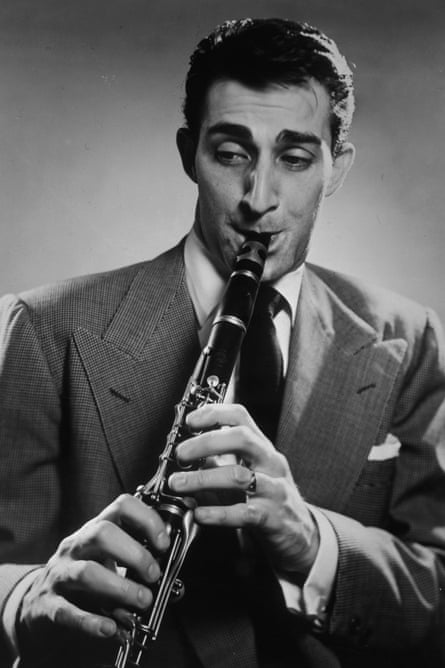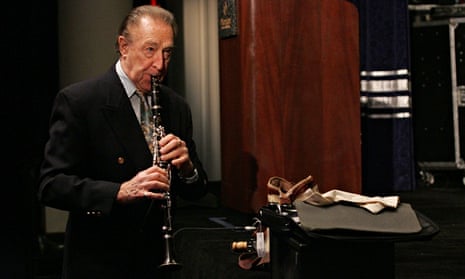The role of the clarinet in jazz changed from vital to marginal in little more than a decade, between the last hurrahs of the big swing bands at the end of the 1930s, and the rise of the unsentimentally byzantine style of bebop. The traditionally woody-toned instrument turned out to be no match for the fiercer saxophone on bop’s edgy melodies, except in the hands of a rare exception in the American musician Buddy DeFranco, who has died aged 91.
In the 21st century, the instrument’s unique personality has reappeared in contemporary jazz through the work of artists including the Americans Don Byron, Joe Lovano and Anat Cohen, and the UK’s Shabaka Hutchings – but during the first wave of the bebop revolution, the prodigious DeFranco was almost alone.
If Benny Goodman, Johnny Dodds, Frank Teschemacher, Artie Shaw and Pee Wee Russell had dominated jazz clarinet in the 1920s and 30s, and Kenny Davern, Eddie Daniels and Bob Wilber had become the celebrated inheritors of their styles, DeFranco was the maverick who investigated the labyrinths and rat-runs of bebop and developed a flawless technique for it. Only the post-second world war clarinettists Tony Scott and Jimmy Giuffre came into the modern frame alongside DeFranco – and though they were regarded by some as warmer and more quirkily expressive players, DeFranco’s playing was far from the coldly efficient exercise it was sometimes caricatured as being.
Though he avoided the idiosyncrasies of pitch and intonation that made more obviously characterful performers of Dodds or Russell, DeFranco had a rich tone, ideas and seamless fluency. He also maintained an exuberant consistency into his 80s, continuing to practise several hours a day, and recording music with younger exponents of the same garrulously lyrical jazz style that he loved.
Originally Boniface Ferdinand Leonardo De Franco, he was born in Camden, New Jersey, but raised in south Philadelphia. He learned to play the mandolin at five, and took up the clarinet four years later. By the age of 14 he had won a national Tommy Dorsey swing contest, and broadcast on the radio programme Saturday Night Swing Club with the star drummer Gene Krupa. At 16 he was on the road with Johnny “Scat” Davis, and a year later working for Krupa, then for Charlie Barnet’s successful orchestra, and for several years – with a brief interlude in Boyd Raeburn’s compositionally advanced band – in a principal soloist’s role with Tommy Dorsey.
DeFranco worked in a variety of small bands in the late 40s and early 50s, which reflected the journey he was beginning to make from swing to bop. Perhaps the months in the 1940s with Raeburn’s group (a composer-led ensemble that was too absorbed in classical/jazz crossovers and structural experiments for its own commercial good) had triggered DeFranco’s interest in more challenging uses for the clarinet.
The popularity of bop in the early 1950s, and the tough postwar economic realities threatening expensive big bands, led several swing players to investigate it, including George Shearing and Count Basie, and DeFranco played for both between 1948 and 1950. In 1952 he was a cornerstone of a swing-to-bop band featuring drummer Art Blakey, initially with the pianist Kenny Drew and then the shortlived Sonny Clark – a version of which band introduced DeFranco to international touring in Europe in spring 1954.

The clarinettist also joined the impresario Norman Granz’s successful Jazz At The Philharmonic all-star package. In 1958 DeFranco was the principal soloist in a premiere of Nelson Riddle’s Cross Country Suite, and he also began conducting jazz education workshops.
Though he was not the kind of radical experimenter to join the free-jazz movement about to explode over the early 1960s scene, departures from jazz orthodoxies clearly fascinated DeFranco. The group he led between 1960 and 1963 – featuring clarinet, accordion, bass and drums – was one of the most unusual in the history of the music.
Despite the burgeoning reputation of Eric Dolphy on the same instrument, DeFranco also attracted admiration for his handling of the sonorous but technically demanding bass clarinet, notably on a fine recording, Blues Bag (1964). But specialising in the clarinet always cramped DeFranco’s creative options, because most progressive leaders in postbop music had little use for it.
He was thus forced back to the styles of an earlier era, leading a legacy orchestra playing Glenn Miller’s music from 1966 to 1974. This project and his teaching work occupied him largely to the exclusion of recording on his own account.
In the next decade De Franco did, however, develop a creative relationship with a virtuoso of similarly divided loyalties, the vibraphonist Terry Gibbs, and his work was also encouraged by the Pablo record label. He also worked regularly with the British guitarist Martin Taylor, the bassist George Duvivier, and the pianists Oscar Peterson and Dave McKenna.
As late as 1989, DeFranco’s work with Duvivier and the guitarist Tal Farlow on the album Like Someone in Love could count among his best recorded work. DeFranco also made regular TV appearances, on the Steve Allen Show, the Jerry Lewis Telethon and Johnny Carson’s Tonight Show among others. He also briefly had his own public television showcase in the US, The Buddy DeFranco Jazz Forum.
A globetrotting artist throughout his life, DeFranco worked with former Charlie Barnet sideman and later Natalie Cole arranger Bill Holman on special projects with West German Radio in Cologne. He was also adopted by Concord Records, a label that has championed boppish mainstream swing for two decades.
Over his long career, DeFranco recorded more than 150 albums. The New Jersey Jazz Society and Rutgers University’s Institute of Jazz Studies elected him into the American Jazz Hall of Fame for exceptional contributions to jazz, and the French clarinettist Fabrice Zammarchi and his wife Syvie Mas related the long and varied story of his life in the biography A Life in the Golden Age of Jazz (2003).
He is survived by his wife, Joyce.

Comments (…)
Sign in or create your Guardian account to join the discussion